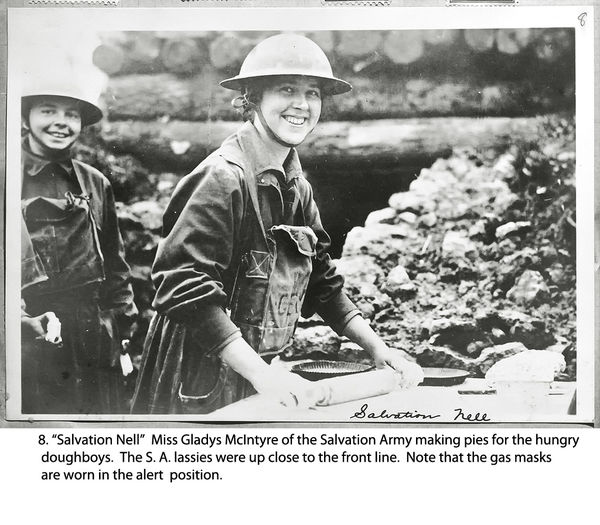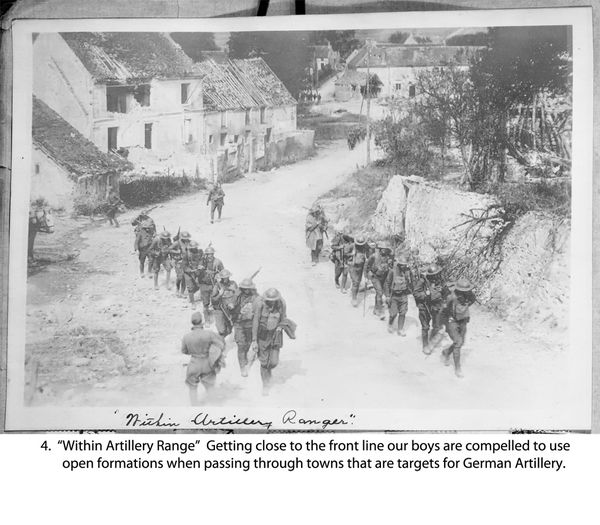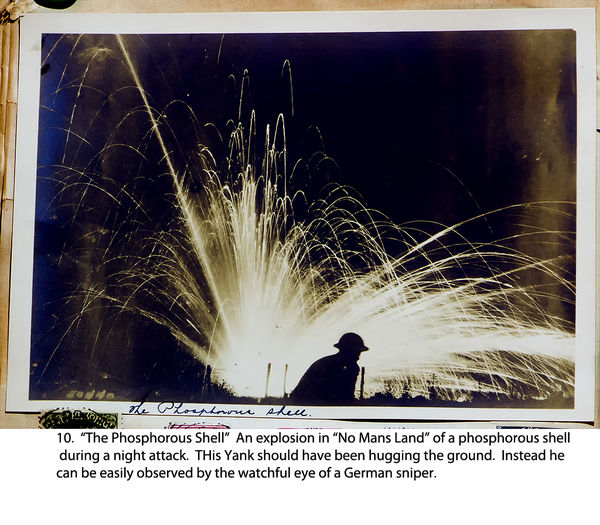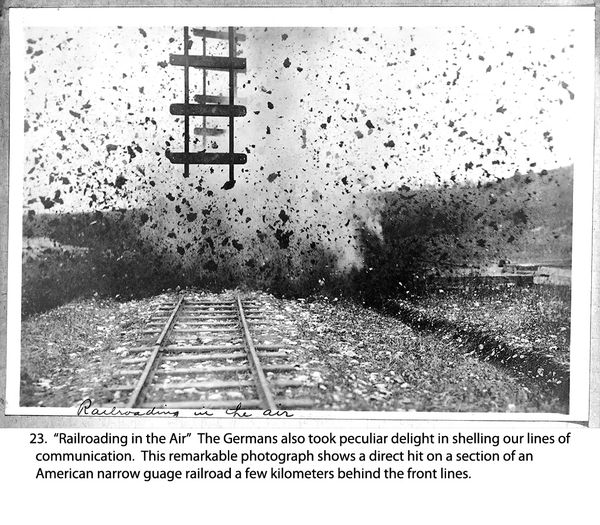Help with WWI photos (France)
Jan 30, 2018 14:22:04 #
downing
Loc: Cincinnati
I purchased a photo-album / scrapbook a few years age. The person from whom I bought it stated his Grand-father (Uncle?) bought it when he was in the US Army in 1922. It does have a notation inside the front cover ÃÂÃÂÃÂâÃÂÃÂÃÂÃÂÃÂÃÂÃÂÃÂPurchased in Paris 1922ÃÂÃÂÃÂâÃÂÃÂÃÂÃÂÃÂÃÂÃÂÃÂ
It contains: Photographic prints, Photo reproductions, Postage stamps, Revenue Stamps, Poster Stamps, Tickets and some other paper items. The photos are basically of two kinds. First is forty prints measuring about 6-7/8 by 4-7./8 inches. Then many smaller ones measuring about 2-7/8 inches by 1-5/8 inches.
The larger ones are described in an accompanying list as a ÃÂÃÂÃÂâÃÂÃÂÃÂÃÂÃÂÃÂÃÂÃÂPhotographic History of the A. E. F. in France 1917-19918.ÃÂÃÂÃÂâÃÂÃÂÃÂÃÂÃÂÃÂÃÂàI have confirmed that at least some of the larger prints are US Army Signal Corps photos. However, they have no Signal Corps logos printed on them.
This means that who ever compiled this album had access to Signal Corps photos during or shortly after the war.
Is the size of these larger photos consistent with the camera that Signal Corps personnel used? Where Signal Corps photos available to other than US Army personnel during the war?
Considering the size of the smaller photos what is the likely camera (Or film) used?
Shown below are some of the larger photos along with their description by the compiler of the album.
4, 8, 10, 23, Most are somewhat faded or yellowed. Converted to black and White.
It contains: Photographic prints, Photo reproductions, Postage stamps, Revenue Stamps, Poster Stamps, Tickets and some other paper items. The photos are basically of two kinds. First is forty prints measuring about 6-7/8 by 4-7./8 inches. Then many smaller ones measuring about 2-7/8 inches by 1-5/8 inches.
The larger ones are described in an accompanying list as a ÃÂÃÂÃÂâÃÂÃÂÃÂÃÂÃÂÃÂÃÂÃÂPhotographic History of the A. E. F. in France 1917-19918.ÃÂÃÂÃÂâÃÂÃÂÃÂÃÂÃÂÃÂÃÂàI have confirmed that at least some of the larger prints are US Army Signal Corps photos. However, they have no Signal Corps logos printed on them.
This means that who ever compiled this album had access to Signal Corps photos during or shortly after the war.
Is the size of these larger photos consistent with the camera that Signal Corps personnel used? Where Signal Corps photos available to other than US Army personnel during the war?
Considering the size of the smaller photos what is the likely camera (Or film) used?
Shown below are some of the larger photos along with their description by the compiler of the album.
4, 8, 10, 23, Most are somewhat faded or yellowed. Converted to black and White.
Jan 30, 2018 14:26:35 #
Jan 30, 2018 14:37:00 #
Keldon
Loc: Yukon, B.C.
Sorry, can't help with your camera queries but I would certainly love to see more samples.
Jan 30, 2018 15:57:37 #
Fantastic images, especially the one of the phosphorus bomb exploding. My daughter just finished a unit on WWI with her five kids - she would love to see this.
Jan 31, 2018 07:28:27 #
Jan 31, 2018 08:24:14 #
I would love to see more of those photos. (My father was there with the "Fighting 69th")
I'm going to guess that the larger images were taken with a 5X7.
I'm going to guess that the larger images were taken with a 5X7.
Jan 31, 2018 09:56:21 #
A little off topic, but I see this "ÃÂÃÂÃÂâÃÂÃÂÃÂÃÂÃÂÃÂÃÂÃÂPurchased in Paris 1922ÃÂÃÂÃÂâÃÂÃÂÃÂÃÂÃÂÃÂÃÂÃÂ" in your post. What did you mean to type?
Jan 31, 2018 10:00:37 #
BobHartung wrote:
A little off topic, but I see this "ÃÂÃÂÃÂâÃÂÃÂÃÂÃÂÃÂÃÂÃÂÃÂPurchased in Paris 1922ÃÂÃÂÃÂâÃÂÃÂÃÂÃÂÃÂÃÂÃÂÃÂ" in your post. What did you mean to type?
These ÃÂÃÂÃ are a software glitch. If you spot them early enough after posting, when edit is still available, go back and erase them
Jan 31, 2018 10:07:36 #
Rich1939 wrote:
These ÃÂÃÂÃ are a software glitch. If you spot them early enough after posting, when edit is still available, go back and erase them
Thanks Rich1939. I never get these, but I seem them on others' posts from time to time.
Jan 31, 2018 10:27:25 #
https://unwritten-record.blogs.archives.gov/
Please go to the above noted site. It's an incredibly fine article about your inquiry.
Please go to the above noted site. It's an incredibly fine article about your inquiry.
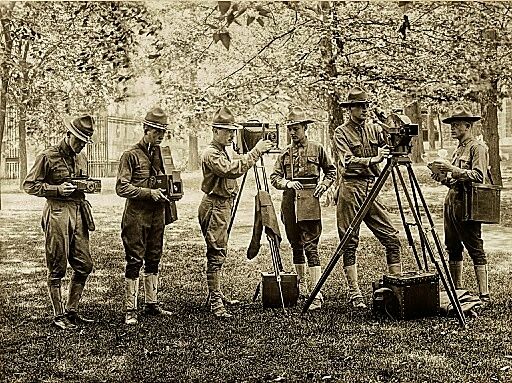
Jan 31, 2018 10:32:53 #
Menu
Search
Shooting World War I: The History of the Army Signal Corps Cameramen, 1917-1918
Posted by Audrey Amidon
For the past two years, the National Archives Motion Picture Preservation Lab has been digitizing a series of Army Signal Corps films as part of a larger project to commemorate the centennial of World War I. Meanwhile, technicians from the Still Pictures Branch and the Digitization Division have scanned tens of thousands of Signal Corps photographs from World War I. Along the way, technician P.T. Corrigan, who performs quality control on the scanned images, forwarded photos of the cameramen to Lab staff, knowing that we love to see records of the people who shot the motion picture films we work with every day.
The following images are from a group of 22 photos documenting the Signal Corps School of Photography at Columbia University in New York. These photos, along with the rest of the series American Unofficial Collection of World War I Photographs, 1917-1918, are available in our online catalog.
Explaining mechanical construction of Akeley camera. In formation for practical camera instruction. Different types of cameras for instruction purposes. Different types of camera used in instruction course.
Akeley camera in operation. Movie class on the campus. Provex motion picture camera instruction.
I recently had a look at the finding aid for the Signal Corps’ “Historical Series” and found a short history of the World War I Signal Corps photographers. The history and finding aid were written by archivist K. Jack Bauer in 1957. Bauer later became a professor at Rensselaer Polytechnic Institute and wrote many books, including histories of the Mexican War and a biography of Zachary Taylor.
111-h-history-cover 111-h history-1 111-h-history-2
The introduction to the finding aid contains a wealth of information about how the Signal Corps Photographic Section was established and how the unit operated. From Bauer’s finding aid:
“Before World War I, the Signal Corps had given relatively little attention to photography, and few officers or enlisted men had much training in that specialized field. On July 21, 1917, the Signal Corps was designated the bureau responsible for obtaining photographic coverage of American participation in World War I. The photographic coverage was ordered for propaganda, scientific, identification, and military reconnaissance purposes but primarily for the production of a pictorial history of the war.
During July 1917 the Photographic Section was established within the Signal Corps to control all photographic activities of the Army. Although initially short of trained men and cameras, the Photographic Section succeeded in building up a large and efficient organization before the Armistice.
A photographic officer accompanied General Pershing to Europe in order to study the methods and equipment of the photographic departments of the Allied Armies. On July 21, 1917, a laboratory was secured at St. Ouen in Paris for developing and printing motion and still pictures. This laboratory served until February 1918, when photographic operations were transferred to larger quarters in Vincennes.
Beginning with 25 men in August 1917, the Photographic Section attached to the AEF [American Expeditionary Forces] reached a strength of 92 officers and 498 men in November 1918. A photographic unit consisting of one motion-picture cameraman and one still-picture photographer, with assistants, was assigned to each division in addition to other units attached to higher organizations, the Services of Supply, the sea transport service, and the various public welfare organizations like the Red Cross and the Salvation Army. Cameramen in the AEF shot 589,197 feet of film, while film units in the United States filmed 277,173 feet of domestic scenes. In addition, the Signal Corps produced a 62,000 foot training film series called “Training of the Soldier” and a 16,000 foot aviation training film entitled “Flightwings.”
Bauer also included a detailed account of how scenes shot by the cameramen were identified, tracked, and described. Ultimately, the film scenes were re-edited to create the “Historical Series” that we know today as 111-H. Until recently, finding a particular scene was a complicated task that required two “crosswalks” to obtain the film’s item number (archivist Richard Green described this process in the 2013 blog post “Finding a Finding Aid”). However, technicians in the motion picture unit have recently completed scanning and uploading text-searchable images of the Signal Corps’ production files for the 111-H series, so all of the films are easily searchable using the National Archives’ online catalog!
Searching for photos of the Akeley camera used by the Signal Corps photographers is what led me to discover this wonderful document, “Instructions for Signal Corps Photographers,” attached to the production file for 111-H-1199. In addition to general advice about taking close-ups and providing detailed descriptions, the guide has more specific instructions, such as warning that “in the moist climate of France,” Xback, a film stock with an anti-static coating, “sticks on the pressure plate and particles may get on the aperture plate causing scratches.” The document also includes details about the proper size of a film loop in the Akeley camera, and how to shoot film from airplanes.
111-h-1199-012-sFinally, below are a few photos from the series technicians are currently scanning. Doubtless, as we continue to scan the films and photographs of World War I, we will uncover more wonderful tidbits of the history of the Signal Corps cameramen. I look forward to finding it all!
This photo, from the Signal Corps series, shows a combined unit of American and French cameramen. The man on the left is a motion picture cameraman for the U.S. Marine Corps, and the man in front is a still photographer and U.S. Marine. (111-SC-4373) Second Lieutenant George E. Stone, Signal Corps, United States Army, in charge Fourth Army Corps Photo Unit. Cochem, Germany.
Signal Corps photographers shoot film with a motion picture camera. (111-SC-4386)
Share this:
TwitterFacebook581Google
Related
Remembering the Vietnam War this Veterans Day
In "Films"
Accessing World War I Photos in the Digital Age
In "Digitization"
Hidden Women: The Art of WWI Camouflage (Photos)
In "Digitization"
March 16, 20174 Replies
« Previous
Next »
Leave a Reply
Your email address will not be published.
Comment
Name
Email
Website
Notify me of new comments via email.
Notify me of new posts via email.
GP Cox on March 17, 2017 at 7:03 am
An Unappreciated and often overlooked group!!
Like
Reply
weggieboy on March 17, 2017 at 7:34 am
I was a US Army motion picture photographer in Germany between 1970-1972. It is interesting to see what my predecessors looked like and what they used to do their jobs! I was used a 16mm Arriflex motion picture camera to do my job, and didn’t have to truck around so much equipment. In WWII, they used 35mm Bell & Howell Eyemo motion picture cameras that were so massive, you could use them for clubs if you ran out of ammo for your handgun! LOL!
Liked by 1 person
Reply
sticher Roman on April 4, 2017 at 9:11 am
Well done.
Keep on going Us National Archive
Like
Reply
Pingback: Shooting World War I: The History of the Army Signal Corps Cameramen, 1917-1918 | The Stuff That Films Are Made Of
View Full Site
Blog at WordPress.com.
:)
Search
Shooting World War I: The History of the Army Signal Corps Cameramen, 1917-1918
Posted by Audrey Amidon
For the past two years, the National Archives Motion Picture Preservation Lab has been digitizing a series of Army Signal Corps films as part of a larger project to commemorate the centennial of World War I. Meanwhile, technicians from the Still Pictures Branch and the Digitization Division have scanned tens of thousands of Signal Corps photographs from World War I. Along the way, technician P.T. Corrigan, who performs quality control on the scanned images, forwarded photos of the cameramen to Lab staff, knowing that we love to see records of the people who shot the motion picture films we work with every day.
The following images are from a group of 22 photos documenting the Signal Corps School of Photography at Columbia University in New York. These photos, along with the rest of the series American Unofficial Collection of World War I Photographs, 1917-1918, are available in our online catalog.
Explaining mechanical construction of Akeley camera. In formation for practical camera instruction. Different types of cameras for instruction purposes. Different types of camera used in instruction course.
Akeley camera in operation. Movie class on the campus. Provex motion picture camera instruction.
I recently had a look at the finding aid for the Signal Corps’ “Historical Series” and found a short history of the World War I Signal Corps photographers. The history and finding aid were written by archivist K. Jack Bauer in 1957. Bauer later became a professor at Rensselaer Polytechnic Institute and wrote many books, including histories of the Mexican War and a biography of Zachary Taylor.
111-h-history-cover 111-h history-1 111-h-history-2
The introduction to the finding aid contains a wealth of information about how the Signal Corps Photographic Section was established and how the unit operated. From Bauer’s finding aid:
“Before World War I, the Signal Corps had given relatively little attention to photography, and few officers or enlisted men had much training in that specialized field. On July 21, 1917, the Signal Corps was designated the bureau responsible for obtaining photographic coverage of American participation in World War I. The photographic coverage was ordered for propaganda, scientific, identification, and military reconnaissance purposes but primarily for the production of a pictorial history of the war.
During July 1917 the Photographic Section was established within the Signal Corps to control all photographic activities of the Army. Although initially short of trained men and cameras, the Photographic Section succeeded in building up a large and efficient organization before the Armistice.
A photographic officer accompanied General Pershing to Europe in order to study the methods and equipment of the photographic departments of the Allied Armies. On July 21, 1917, a laboratory was secured at St. Ouen in Paris for developing and printing motion and still pictures. This laboratory served until February 1918, when photographic operations were transferred to larger quarters in Vincennes.
Beginning with 25 men in August 1917, the Photographic Section attached to the AEF [American Expeditionary Forces] reached a strength of 92 officers and 498 men in November 1918. A photographic unit consisting of one motion-picture cameraman and one still-picture photographer, with assistants, was assigned to each division in addition to other units attached to higher organizations, the Services of Supply, the sea transport service, and the various public welfare organizations like the Red Cross and the Salvation Army. Cameramen in the AEF shot 589,197 feet of film, while film units in the United States filmed 277,173 feet of domestic scenes. In addition, the Signal Corps produced a 62,000 foot training film series called “Training of the Soldier” and a 16,000 foot aviation training film entitled “Flightwings.”
Bauer also included a detailed account of how scenes shot by the cameramen were identified, tracked, and described. Ultimately, the film scenes were re-edited to create the “Historical Series” that we know today as 111-H. Until recently, finding a particular scene was a complicated task that required two “crosswalks” to obtain the film’s item number (archivist Richard Green described this process in the 2013 blog post “Finding a Finding Aid”). However, technicians in the motion picture unit have recently completed scanning and uploading text-searchable images of the Signal Corps’ production files for the 111-H series, so all of the films are easily searchable using the National Archives’ online catalog!
Searching for photos of the Akeley camera used by the Signal Corps photographers is what led me to discover this wonderful document, “Instructions for Signal Corps Photographers,” attached to the production file for 111-H-1199. In addition to general advice about taking close-ups and providing detailed descriptions, the guide has more specific instructions, such as warning that “in the moist climate of France,” Xback, a film stock with an anti-static coating, “sticks on the pressure plate and particles may get on the aperture plate causing scratches.” The document also includes details about the proper size of a film loop in the Akeley camera, and how to shoot film from airplanes.
111-h-1199-012-sFinally, below are a few photos from the series technicians are currently scanning. Doubtless, as we continue to scan the films and photographs of World War I, we will uncover more wonderful tidbits of the history of the Signal Corps cameramen. I look forward to finding it all!
This photo, from the Signal Corps series, shows a combined unit of American and French cameramen. The man on the left is a motion picture cameraman for the U.S. Marine Corps, and the man in front is a still photographer and U.S. Marine. (111-SC-4373) Second Lieutenant George E. Stone, Signal Corps, United States Army, in charge Fourth Army Corps Photo Unit. Cochem, Germany.
Signal Corps photographers shoot film with a motion picture camera. (111-SC-4386)
Share this:
TwitterFacebook581Google
Related
Remembering the Vietnam War this Veterans Day
In "Films"
Accessing World War I Photos in the Digital Age
In "Digitization"
Hidden Women: The Art of WWI Camouflage (Photos)
In "Digitization"
March 16, 20174 Replies
« Previous
Next »
Leave a Reply
Your email address will not be published.
Comment
Name
Website
Notify me of new comments via email.
Notify me of new posts via email.
GP Cox on March 17, 2017 at 7:03 am
An Unappreciated and often overlooked group!!
Like
Reply
weggieboy on March 17, 2017 at 7:34 am
I was a US Army motion picture photographer in Germany between 1970-1972. It is interesting to see what my predecessors looked like and what they used to do their jobs! I was used a 16mm Arriflex motion picture camera to do my job, and didn’t have to truck around so much equipment. In WWII, they used 35mm Bell & Howell Eyemo motion picture cameras that were so massive, you could use them for clubs if you ran out of ammo for your handgun! LOL!
Liked by 1 person
Reply
sticher Roman on April 4, 2017 at 9:11 am
Well done.
Keep on going Us National Archive
Like
Reply
Pingback: Shooting World War I: The History of the Army Signal Corps Cameramen, 1917-1918 | The Stuff That Films Are Made Of
View Full Site
Blog at WordPress.com.
:)
If you want to reply, then register here. Registration is free and your account is created instantly, so you can post right away.
